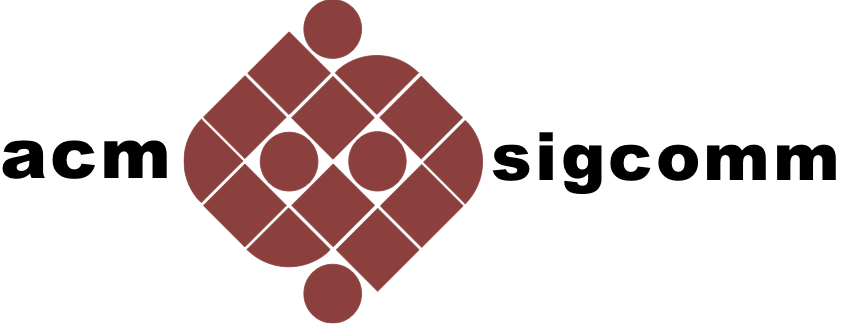ACM SIGCOMM 2018 Afternoon Workshop on Kernel Bypassing Networks (KBNets 2018)
Workshop Program
- Opening
-
2:05 pm - 2:40 pm Keynote I: RDMA-Based Networking Technologies and Middleware for Next-Generation Clusters and Data Centers
Speaker: D. K. Panda (OSU, USA)
Location: InterContinental, Ballroom II
-
2:40 pm - 3:15 pm Keynote II: To RDMA and Beyond
Speaker: Eitan Zahavi (Mellanox, Israel)
Location: InterContinental, Ballroom II
-
3:15 pm - 3:45 pm Tea/Coffee Break
Location: InterContinental, Pre-Function Area
- Tea/Coffee Break
- Technical Session
-
3:45 pm - 4:10 pm Circuit Switched VM Networks for Zero-Copy IO
Johannes Krude, Mirko Stoffers, Klaus Wehrle (RWTH, Germany)
-
4:10 pm - 4:35 pm A Formally Verified NAT Stack
Solal Pirelli, Arseniy Zaostrovnykh, George Candea (EPFL, Switzerland)
-
4:35 pm - 5:00 pm Flow control for Latency-Critical RPCs
Marios Kogias, Edouard Bugnion (EPFL, Switzerland)
-
5:00 pm - 5:25 pm Hash Table Design and Optimization for Software Virtual Switches
Yipeng Wang, Sameh Gobriel, Ren Wang, Tsung-Yuan Charlie Tai, Cristian Dumitrescu (Intel, USA)
- Closing
Call for Papers
Kernel Bypassing Networks (including, but not limited to RDMA, DPDK and SmartNIC) have recently drawn much attention from both the research community and the industry. Emerging applications such as AI training, distributed storage systems, virtual networking, and software middleboxes/NFV demand low latency, high bandwidth and low CPU overhead from the network, and have been shown to benefit significantly from technologies that bypass the conventional OS network stack. At the same time, recent switch and NIC developments (e.g., RoCE) have paved the way to the largescale deployment of KBNets.
KBNets are thus starting to be deployed in practice. But plenty of research remains to be done. For example, the research community is still debating whether the kernel should be bypassed in different usecases, what sort of control plane and network management systems are needed for such networks, and how to design congestion control protocols for KBNets and deal with inherent problems such as deadlocks, and how to design programming languages for KBNets. Perhaps more importantly, there is much more work needed to understand how KBNets will impact the design of distributed systems and applications that run over these networks.
We believe that networking community must expedite the research on the design of kernel bypassing networks, understand both their strengths and their weaknesses, and rethink how we design distributed systems to take advantage of these networks.
The ACM SIGCOMM Workshop on Kernel Bypassing Networks (KBNets 2018) is organized with the goal of bringing together researchers from the networking, operating systems, and distributed systems communities to promote the development and evolution of kernel bypassing networks. All submissions related to KBNets and KBNetsbased systems, including network/system architecture, design, implementation, programing language, simulation, modeling, analysis, and measurement will be welcome. We highly encourage novel and innovative early stage work that will encourage discussion and future research on KBNets.
Topics of Interest
Topics include but are not limited to:
- Network transport for kernel bypassing networks
- Control plane for kernel bypassing networks
- Security issues regarding kernel bypassing networks
- Distributed systems that are based on kernel bypassing networks, e.g., AI training, distributed storage, database and inmemory caches
- Data center network architectures for kernel bypassing networks
- Virtualization for kernel bypassing networks
- Programming languages for kernel bypassing networks
- NIC/switch hardware design for kernel bypassing networks
- Middleboxes/NFV optimization with kernel bypassing networks
- Diagnosing and troubleshooting kernel bypassing networks
- Experiences and bestpractices in deploying kernel bypassing networks
- Measurements of kernel bypassing and kernel optimizing networks
- Performance studies of kernel bypassing networks and applications
- Transition and backward compatibility with traditional network stacks
- Other approaches such as high performance OS dataplane architectures
Submission Instructions
Submissions must describe original, previously unpublished, complete research, not currently under review by another conference or journal.
Papers must be submitted electronically. The length of papers must be no more than 6 pages, including tables and figures, (in two-column, 10-point format) but excluding references, following the provided ACM LaTeX style file https://github.com/scyue/ccp-sigcomm18. The cover page must contain the name and affiliation of author(s) for single-blind peer reviewing by the program committee. Each submission will receive at least three independent blind reviews from the TPC. At least one of the authors of every accepted paper must register and present their work at the workshop.
Please submit your paper via http://sigcomm18kbnets.hotcrp.com/
Authors Take Note
The official publication date is the date the proceedings are made available in the ACM Digital Library. This date may be up to TWO WEEKS prior to the first day of the conference. The official publication date affects the deadline for any patent filings related to published work.
Registration
Attendance of the workshop is by open registration and subject to the same registration fees and rules as all the other SIGCOMM 2018 workshops. The registrants of the workshop may freely attend any workshop on the same day.
Camera-ready instructions
For the final paper to be published, please refer to Camera-ready instructions for workshops.
Important Dates
-
August 20, 2018
Workshop
-
Mid-June, 2018
List of organization details
-
Mid-June, 2018
Program available online
-
June 10, 2018
Camera-ready deadline
-
April 30, 2018Acceptance notification
-
April 01, 2018Paper submission deadline
Committees
- Workshop Chairs
-
Dongsu Han
KAIST, South Korea
-
Hongqiang Liu
Alibaba, China
- Program Committee Members
-
Nandita Dukkipati
Google, USA
-
Felipe Huici
NEC, Germany
-
Xin Jin
JHU, USA
-
Richard Mortier
Cambridge, UK
-
Aurojit Panda
NYU, USA
-
D. K. Panda
OSU, USA
-
Kyoungsoo Park
KAIST, South Korea
-
Simon Peter
UT, USA
-
Jitendra Padhye
Microsoft, USA
-
Costin Raiciu
UPB, Romania
-
Timothy Wood
GWU, USA
-
Eitan Zahavi
Mellanox, Israel
-
Yibo Zhu
Microsoft, USA

 Bio: DK Panda is a Professor and University Distinguished Scholar of
Computer Science and Engineering at the Ohio State University. He has published over 450 papers in the area of high-end computing and networking. The MVAPICH2 (High Performance MPI and PGAS over InfiniBand, Omni-Path, iWARP and RoCE) libraries, designed and developed by his research group (http://mvapich.cse.ohio-state.edu), are currently being used by more than 2,900 organizations worldwide (in 86 countries). More than 473,000 downloads of this software have taken place from the project's site. This software is empowering several InfiniBand clusters (including the 1st, 9th, 12th, 17th, and 48th ranked ones) in the TOP500 list. The RDMA packages for Apache Spark, Apache Hadoop and Memcached together with OSU HiBD benchmarks from his group (http://hibd.cse.ohio-state.edu) are also publicly available. These libraries are currently being used by more than 285 organizations in 34 countries. More than 26,600 downloads of these libraries have taken place. A high-performance and scalable version of the Caffe framework is available from http://hidl.cse.ohio-state.edu. Prof. Panda is an IEEE Fellow. More details about Prof. Panda are available at http://www.cse.ohio-state.edu/~panda.
Bio: DK Panda is a Professor and University Distinguished Scholar of
Computer Science and Engineering at the Ohio State University. He has published over 450 papers in the area of high-end computing and networking. The MVAPICH2 (High Performance MPI and PGAS over InfiniBand, Omni-Path, iWARP and RoCE) libraries, designed and developed by his research group (http://mvapich.cse.ohio-state.edu), are currently being used by more than 2,900 organizations worldwide (in 86 countries). More than 473,000 downloads of this software have taken place from the project's site. This software is empowering several InfiniBand clusters (including the 1st, 9th, 12th, 17th, and 48th ranked ones) in the TOP500 list. The RDMA packages for Apache Spark, Apache Hadoop and Memcached together with OSU HiBD benchmarks from his group (http://hibd.cse.ohio-state.edu) are also publicly available. These libraries are currently being used by more than 285 organizations in 34 countries. More than 26,600 downloads of these libraries have taken place. A high-performance and scalable version of the Caffe framework is available from http://hidl.cse.ohio-state.edu. Prof. Panda is an IEEE Fellow. More details about Prof. Panda are available at http://www.cse.ohio-state.edu/~panda.
 Bio: Dr. Eitan Zahavi, a Distinguished Architect and co-founder of Mellanox.
Eitan leads the Mellanox network architecture group focusing on cluster level performance.
He also acts as a co-chair of the IBTA technical working group.
Dr. Zahavi teaches Logic Design Automation for VLSI systems in the Technion EE department.
He received his Ph.D. about “Forwarding in Compute Clusters” in 2015 and Bs.C. in 1987
both at the EE department of the Technion, Israel institute of technology.
Bio: Dr. Eitan Zahavi, a Distinguished Architect and co-founder of Mellanox.
Eitan leads the Mellanox network architecture group focusing on cluster level performance.
He also acts as a co-chair of the IBTA technical working group.
Dr. Zahavi teaches Logic Design Automation for VLSI systems in the Technion EE department.
He received his Ph.D. about “Forwarding in Compute Clusters” in 2015 and Bs.C. in 1987
both at the EE department of the Technion, Israel institute of technology.

















